
Official Edgar Rice Burroughs Tribute Site Since 1996 ~ Over 15,000 Webpages in Archive Presents Volume 1512 THE OTHER MOON MAID,
|

Official Edgar Rice Burroughs Tribute Site Since 1996 ~ Over 15,000 Webpages in Archive Presents Volume 1512 THE OTHER MOON MAID,
|
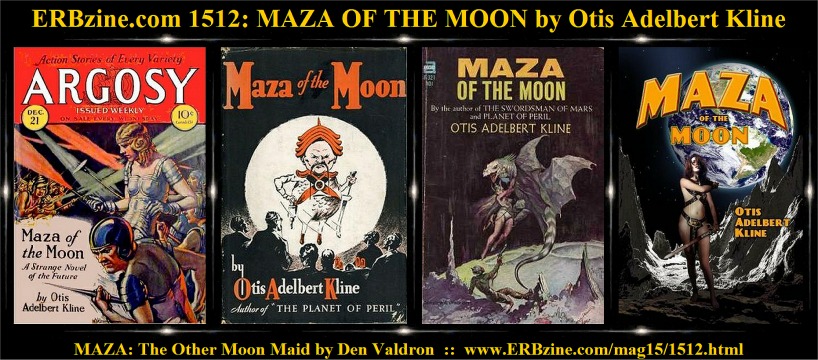
|
(5,520 words)
Maza of the Moon fits, through overlapping references with Swords of Mars, into an Otis Kline continuity that another fan calls the Doctor Morgan stories, largely because a figure named Doctor Morgan appears in almost all of the novels and stories as a kind of framing character. Doctor Morgan doesn't appear here because it's set some thirty some years into the future (Kline's future), but the correspondence with Swords of Mars puts it in the same universe. 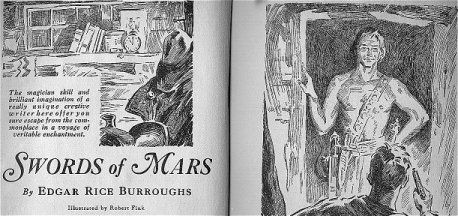 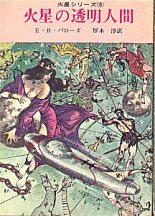
Maza was his principle Moon novel. But it appears that at least one of his short stories, "Man from the Moon" also fits into this continuity. A look at his bibliography shows another novel or novella, Race Around the Moon. And of course, there may be stories that are related to the Maza moon, whose titles do not betray them.
MAZA OF THE MOON - SYNOPSIS All right, we have young man about town, Ted Dustin, who also happens to be an engineering genius. Dustin has previously revolutionized industry back in the '50s by perfecting solar energy eliminating the need for coal and oil. Since then, he's been pursuing the secrets of atomic energy, but wouldn't you know it, he's running out of money. It's 1964, and there is a prize for the first person who actually manages to get any kind of object to the moon. So Ted builds a big cannon in the Galapagos, stakes his entire company on it, and shoots for the moon. Along the way, we get some glimpses of futuristic technology, including video telephones that are voice controlled. But mostly, America of 1964 isn't too different from America of the thirties. Well, it turns into a good news/bad news situation. Dustin's missile hits the moon on March 16. But unfortunately, the island he's launched from blows up. It seems that the shock of the moon launch triggered the unstable geology and it went all volcanic. Unfortunately, the observation stations are on or around the island. Dustin can't prove that he's hit the moon, apparently because no one else in the world was watching, so he can't collect the prize, and he's ruined financially. On May 5, there are a series of five flashes from the moon crater, Ptolemy, followed by big meteors hitting on or near five major cities. It seems that the Moon has decided to hit back. Ted Dustin is commissioned by the President to get in touch with the moon, through an ultra-powerful radio/television and send a message of peace. Something along the lines of "Sorry we blew up your planet, our bad. Now stop firing missiles at us." In response, a beautiful semi-nude female figure appears in the view screen. Ted is entranced. But she only has a few seconds to utter a few unintelligible words when the view screen goes all wonky. Out goes the moon porn channel, to be replaced by a fat yellow guy with Fu Manchu mustaches and a pagoda on his head. He addresses Earth in a language resembling ancient Chinese. After some back and forth with a Chinese linguist, a Doctor Wu, the Moon men send a written message. A few words are understood. "P'an-ku" the name of the Moon man with the pagoda on his head is also the name of the 'first man' or Chinese version of Adam. They and Doctor Wu go away to decipher the text message, which, once they unravel it, turns out to be something along the lines of "You hit us! Why would you do a thing like that! Surrender or we'll kick your ass!" Well, diplomacy is called for. So the Earthlings, using Doctor Wu, send a message which they intend to say, "Sorry about that, big misunderstanding, peace and friendship?" Strangely, both the beautiful semi-nude girl and the fat, pagoda hat-wearing guy react with horror. The transmission with the girl lasts longer, long enough for them to learn her name is "Maza an Ma Gong." They and Dustin also exchange a 'rosetta stone' of matching characters that will allow each to decipher the others written language. Actually, because of perfidious albion (no wait, wrong country, it's actually sneaky Manchuria) says, "Bite us you smelly wog! We got plenty more where that came from!" (Freely translated, its not exactly what Kline relates). The yellow ruler of the moon determines on the conquest of those snotty Earth people, particularly the white ones. The result is a new round of missiles from the moon, falling on earthly cities. They also stop returning phone calls from Earth, which really hurts. So, Ted Dustin does what any sensible 'Flash Gordon' type of hero does. He builds his own little space ship, which he's had time to invent whilst the Moon people have been in a snit, arms it with disintegrator rays, which he's also had time to invent, and takes off for the moon. Okay, to be fair, even in 1930, putting it like that was stretching credibility. The truth is, that Dustin's been working on this marvelous new technology based on manipulating fundamental forces like gravity and nuclear attraction at the atomic level for quite some time. And he's been going broke doing it. His private moon shot was actually the prototype test for his new technology. So, he's merely gone the next step and adapted it for a smaller, slower craft. His disintegrators are actually just another application for the technology. It still seems farfetched that one man could come up with all that, and working on the sly. But remember, this was the age of guys like Nikola Tesla and Thomas Edison, and there were men like Einstein, Ford, Turing, Goddard and Oppenheimer rolling around. So you never knew what they were going to come up with next. Of course, taking off for the moon with no actual plan.... Yes, that is genuinely stupid. Even assuming that he doesn't die of radiation poisoning, get cooked to death, run out of air or any of a hundred other fates, what's he going to do when he gets there. Somehow, I suspect that 'little Dustin' has started doing his thinking for him. While Dustin's heading for the moon though, the Moon folk attack again. This time, the Moon shines green, and a large section of North America goes into a subzero deep freeze. It seems that the moon folk are stealing weapons from Batman villains - they've got a planet-sized freeze ray. This is followed up with another attack, a trio of Moon spaceships, flying Globes which shoot green disintegrator rays, attack Earth. The moon globes chase around Dustin's pal Roger (Roger is his second in command), and kidnap an Earth professor of ancient Chinese. But that's mostly accidental. Meanwhile, off on the moon, Dustin checks out the target of his own missile, the Hipparchus crater. Descending, Ted finds in the outskirts of the blast area, strange plants, one of which tries to eat him. Luckily, he's rescued by Maza, the porn-girl from the video, riding a small flying dragon-lizard and firing a red disintegrator ray. Maza and Dustin are wearing space suits to protect them from the harsh environment, including temperatures of hundreds of degrees fahrenheit and very thin air. The dragon doesn't seem bothered. You've got to admire Dustin's luck. He's coincidentally been found by the one person on the entire moon who isn't going to slice and dice him on sight, just in time to be saved from a man eating fern! He agrees to follow her home, but it's not too long before her dragon gets shot down by a yellow man. She and the yellow man have a fencing match with red and green rays. The yellow men have green disintegrator rays, the Princess has a red one. Dustin's disintegrator ray is colourless, so he feels sort of left out. Dustin gets shot down. He's back to having a bad day. Princess Maza gets abducted by the yellow men who fly off in their globe. Dustin manages to hitch a ride, and winds up in the underground city of yellow men... Or what's left of it. Dustin has to walk through the corpses of people that he has killed, which is a nice touch. And actually, it's worth a little explanation. All too often in these pulp novels, the heroes are utter shits. I mean, they kill people, particularly people of other races, they steal, they lie, their actions are often peremptory and violent. In real life, they'd be serving 20 to life for their actions, but because they're heroes and they're doing it to foreigners or aliens, it's somehow all right. One small wrinkle in Maza of the Moon, is that Kline does acknowledge that Ted Dustin is, although inadvertently, a mass murderer. In moments like this, he sort of acknowledges that fact. It's an adventure book, so there isn't any time wasted on guilt. But nevertheless, it's clear what the consequences of his actions are, and it's also clear that whatever other machinations are going on with the evil yellow emperor, Ted started off the war. It's all his fault. Again, Kline doesn't really dwell on it. But he acknowledges it, which is pretty good for these kinds of stories. It makes you think that Kline may have had it in him to write better books, who knows. Anyway, Dustin manages to rescue the girl, and after that, they trudge picturesquely through the jungle that still survives at the bottom of lunar canyons. Lots of reptiles and dinosaur critters, live versions of Chinese parade dragons, and strange vegetation. A dragon flies off with the princess, he has to rescue her again. We can see this is going to become a pattern. Meanwhile, back on Earth, the Yellow Lunar people's flying globes attempt to ally with Imperial China (the communists hadn't taken over in this reality) -- apparently through some sort of cultural bond. However, the Chinese citizens will have nothing to do with these lunar interlopers and overthrow their government. The Japanese say 'no thanks' as do the rest of the Asian nations. However, Dustin's pal Roger, holding the fort on Earth, begins working on a big disintegrator ray, based on Dustin's designs. At the same time, Professor Ederson, who is an expert in ancient Chinese languages gets picked up by the yellow lunar men, who take the time out to explain the history of their world. It seems that once upon a time, the Moon was in independent planet. They got into a war with Mars, got their ass kicked, and wound up as a satellite of Earth with their civilization destroyed. The white lunar people are Martian expatriates. The two civilizations have been crawling back up from the ashes the last few thousand years, and the yellow people have only recently regained space travel. All I can say is: Bad Timing, Dustin! Anyway, the White Martian/Lunarians are based in the crater Tycho, and the ray system of Tycho, which is actually a network of glassed over canyons. The city that was destroyed was a mostly yellow city at Hipparchus. The Yellow kingdom is based around Copernikus. Ted and Maza make it to Tycho, where he finds that Maza is queen of one of the two nations of the Moon. There he learns the common language. Ted discovers that the P'an'ku, or the Yellow Moon men are shooting a giant green ray at Earth. This is what causes the ice age effect. Ted, being a dolt, decides to destroy the ray single handedly. His big accomplishment is to get captured. Maza, showing a remarkable lack of judgment, raises her army to rescue Ted. She gets captured. Luckily, Ted finds a P'an'ku scientist, the very guy who has reinvented the flying globes and death rays and stuff, also chained up with him. Together, they stage an escape and go on a rampage. But of course, everyone gets captured. All seems lost, when Roger, in an aerial battleship based on Ted's designs, shows up to kick ass. This is what Ted should have been working on in the first place. Because think about it, if he'd acted sensibly, he wouldn't have crashed on the Moon, Maza wouldn't have had to rescue him, he wouldn't have been captured, she wouldn't have been captured, and the P'an'ku would have been sorted out anyway. But then of course, we wouldn't have had all that coincidence-based Flash Gordon adventure and romance happening. Anyway, everything works out. The evil emperor is dethroned, the virtuous P'an'ku take power, and the two nations of the moon are reunited. Dustin marries Maza, and presumably, they live happily ever after. 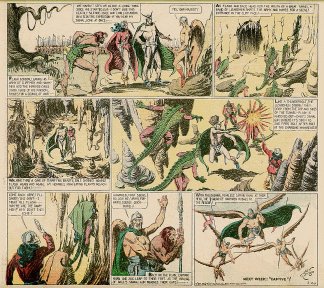 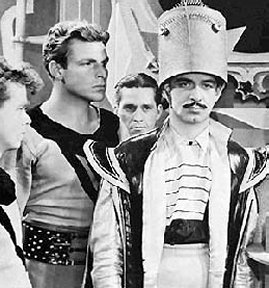
But then again, it's one of those things. Arguably, truly original forms are rare and most writers just follow in the paths set out. Its likely that many had the imagination to invent a particular form, but once someone does it... such as the Jungle man or the interplanetary romance, they may not have much ability or motivation to go beyond that. So Kline wrote very well in established tracks, perhaps that's as valid as writing poorly in original tracks. Who knows.
What is more interesting is the history which is implicit in Kline's 'Doctor Morgan' series (so named by J. P. Huckenpohler, or so I believe). This provides an interplanetary timeline going way back. Essentially, within Otis Kline's interplanetary books, something like a chronological order emerges... Beginning - Undefined early period, human races occur on many planets in the solar system, including Mars, the Moon, Earth and Venus, as well as other bodies, possibly Mercury, Jupiter and/or Satellites, etc. (reference from Maza of the Moon). The Moon or Luna is a separate planet occupying an independent orbit between Earth and Mars. Early Space Travel - The people of the lunar surface, the yellow Ma Gongi develop a high civilization and begin space travel. Their explorations prove disappointing, although they find human races on other worlds, most of them are barbarous. Only on Mars is there a civilization, made up of whites, which rivals their own. - Initially the two civilizations get along well, even to the point of establishing colonies on each other's worlds. It turns out that the Ma Gongi of Swordsman of Mars really are from Luna. Boy, is my face red, considering how I mocked that notion. Also, it turns out that the white Lunarians in Maza of the Moon are actually transplanted Martians (Orovars?). - The Yellow Ma Gongi appear to have established other colonies as well. Maza of the Moon indicates that there are linguistic and ethnic connections between the Ma Gongi and the far eastern Asian peoples, particularly the Manchu or Han Chinese. - Jan of the Jungle finds a lost race of yellow oriental people who worship Quetzalcoatl, a dragon-like snake, sharing a hidden valley with a lost colony of Mu. Given the ethnic and historical disconnects, it's tempting to see these as the half-breed offspring of another Ma Gongi colony. It's kind of thin, but this suggests that Jan of the Jungle may fit into Kline's 'Doctor Morgan Universe.' - Also, Port of Peril features a yellow-skinned, short, pot-bellied race with a culture resembling terrestrial orientals who are almost certainly derived from the Ma Gongi. - Assuming that the Martians (Orovars) also travelled space and left at least one colony on the Moon, they may have also travelled to Earth and Venus. The Zarovians may actually be descendants of stranded or refugee Orovars. (That's just a wild assed speculation, apart from a few linguistic references, I can't back it up at all). - Nothing much is going on with Earth around this time. The only civilization of note is Mu, which gives rise to Lemuria and Atlantis. But none of them seem to get much past bronze/early iron age, and they aren't taken seriously by either the Martians or the Ma Gongi. The nascent Earth civilizations collapse or vanish, possibly as a by-product of the war between the planets. - War breaks out between Mars and Luna. The respective space fleets battle and are mutually wiped out, though the Martians retain more space travel capacity. The Martians employ a series of asteroid strikes which devastate the Moon's surface. - The Ma Gongi respond by attempting to move their Moon out of the way, moving within the orbit of Earth so that Earth will act as a shield (unlucky us!!!) However, accumulating damage from the Martians leaves the Ma Gongi less able to control their planet, and so they opt to park it in a stable orbit. - The Martians, however, don't escape unscathed. The Ma Gongi build giant ray projectors to destroy Mars atmosphere and sterilize the planet. Unfortunately, since they're building their ray projectors on the surface of the Moon, they're destroying their own atmosphere faster and more thoroughly. Given that the Moon's atmosphere is likely less dense and with far less volume to start with, and given the proportionately greater effect of their rays up close rather than at 20 million miles distance, the Ma Gongi tactic seems to speak of sheer, utter desperation. The Martians were kicking their asses big time. - In Maza of the Moon, the Ma Gongi yellow lunar civilization builds a similar giant projector to attack Earth. At a great distance, the attenuated beam merely steals heat away, causing sub zero temperatures on parts of the US. I'm assuming that a similar effect was seen on Mars, and that the effects on atmosphere and oceans were accompanied by an artificially induced runaway Martian ice age. As you know, I've theorized that the collapse of Orovar civilization was driven by a runaway ice age. Now we know what caused it. - It's not at all clear, however, that the war destroyed Mars utterly. The Ma Gongi leader was able to escape from Mars because there was no one left to hold him. On the other hand, Swordsman and Outlaw of Mars are set well after the time of this war. In Maza of the Moon, set around 1964, the Ma Gongi Emperor announces his plans to conquer Mars, which suggests that the Martian civilization is still around by the 20th century. - The Ma Gongi leader, upon his escape from Mars, returns to find a barren and devastated Moon. Thinking it a dead world, he heads to Earth to found an empire among the savages. He is venerated by the Chinese as 'Adam' or the first man, and his language becomes the archaic chinese language. So he either founds or takes over early Chinese civilization. It's not clear whether there were other Ma Gongi on the planet before him. The prominence of ethnic, linguistic and cultural features, however, suggests that there was some sort of Ma Gongi colony pre-existing. Whether it was a prison camp, political exiles, puritan malcontents or whatever, is not clear. - However, there's a conundrum here. Doctor Morgan claims that Jerry Morgan and Harry Thorne's Mars is millions of years in the past. But that doesn't jibe with the events reported in Maza of the Moon. If Doctor Morgan is correct, then the war between the Martians and Ma Gongi must have taken place even further in the past, millions of years. Yet, the Ma Gongi leader founded or took over early Chinese civilization. - Early Chinese civilization is not millions of years old. In our Universe, it may be no older than five thousand at most, six or seven thousand at the outside. In Kline's Universe, civilization, particularly Mu, Lemuria and Atlantis goes back to the last ice age, so perhaps a few tens of thousands of years. Assuming the most generous possible dating, the War between the Moon and Mars could not have taken place any earlier than 10,000 to 50,000 years ago. - However, Martian books take place after that war, and in particular, they take place long enough after that war for Martian society and ecology to stabilize. So generously, give at least 10,000 years. - Which means that Outlaws of Mars and Swordsman of Mars, as well as the Venus books, must all be taking place, not millions of years ago, but in some time frame somewhere between 40,000 years ago and the present. - The situation is somewhat complicated by Doctor Morgan's assertion in Planet of Peril that the Martian, Lal Vak's descriptions of Earth led Morgan to the conclusion that Lal Vak was looking at a prehistoric Earth, just as Morgan was looking at a dead Mars. But there are no details. What was Lal Vak describing, strange giant creatures? Ice caps? Was Lal Vak describing Mammoths and Baluchitheriums and other creatures that Morgan knew to be extinct? How good were Lal Vak's observations? His best vantage point would have been Earth's tropical regions, perhaps Lal Vak merely butchered a description of Earth's tropical flora and fauna, assumed it was current the whole planet over, and Morgan took that as confirmation of prehistoric beasts. Alternately, perhaps Lal Vak described glaciation which might simply have been normal ice caps or winter whiteness, and Morgan took this as a description of ice age glaciation. Or perhaps Lal Vak wasn't going on his own observations, but merely referring to his own ancient records of Earth and assuming that nothing much had changed? In any event, there's a conundrum here. - Fast forward to the present, Doctor Morgan makes psychic contact with Lal Vak of Mars. Between the two of them, they figure out a means of psychic exchange, and Morgan sends Boyd to Mars. Boyd then goes renegade. - Morgan then sends Harry Thorne to sort Boyd out, receiving Borgen Thakkor of Mars. - Some time after this, Morgan makes contact with Varn Vangel of Venus. - There are intervening, or perhaps unsuccessful experiments. In Outlaw of Mars, Doctor Morgan tells his nephew, Jerry Morgan, that he already has two representatives on Venus. These cannot be either of the men in the Planet of Peril novels. They must therefore be other experiments who either failed, or whose fates have not been chronicled. - In Prince of Peril, Doctor Morgan also admits that there was at least one attempt at interplanetary transfer which failed because the two subjects were not sufficiently closely matched. This is also not chronicled. - At some point, Jerry Morgan is sent to Mars in the Outlaw of Mars. This takes place after Harry Thorne and Boyd go to Mars, but before Borgen Thakkor and Robert Grandon were sent to Venus. - Borgen Thakkor spends ten years on Earth as Harry Thorne, before he is sent to Venus as Prince Zinlo. Robert Grandon is also sent to Venus at the same time as Borgen Thakkor, and their adventures, in Planet of Peril and Prince of Peril, take place simultaneously. Robert Grandon reads the manuscripts of both Harry Thorne and Jerry Morgan, so we know his adventure comes after both of theirs. - Now things get a bit interesting, because going by the bibliography, the adventures are chronologically happening completely out of the order that they're being published in. This may mean that they're occurring in the order of magazine publication. Or it may be that either while writing, or after the fact, Kline imposed his own chronology on events. - Things get even more interesting, given that the Harry Thorne Swordsman adventure is explicitly taking place ten chronological years before the first two venus adventures. The adventures cannot be taking place later than the year of book publication, which puts Harry Thorne as early as 1920-1922. - Even more interesting, the Bride of Osiris introduction notes that Planet of Peril was Kline's first novel, written in 1922!!! Kline’s own autobiographical note says that he started writing Planet of Peril in 1921. The book was not actually published until 1929, years later. However, if the date of the draft is relevant and the actual time of Planet of Peril... then Harry Thorne's adventure must have taken place somewhere around 1911-1912!!! Or very close to Princess of Mars date of publication (though of course, John Carter's arrival on Mars is back in the 1860s). - Anyway, it seems a bit dicey and interesting, but there's definitely latitude for interpretation. Doctor Morgan himself visits Venus at the end of Planet of Peril, meeting both Borgen Thakkor/Harry Thorne and Robert Grandon. Their bodies on Earth are dead, as their exchanges have killed themselves. They're stuck on Earth. Morgan has mastered physical travel, having recovered and rebuilt Jerry Morgan's travel vehicle. - The final Venus novel takes place a short time after the events of the first two novels. Robert Grandon is still trying to have a honeymoon, so at best, we're looking at maybe a year. - At undefined points around this time, say the '20s and '30s, the events of Jan of the Jungle, Jan in India and Tam Son of the Tiger probably occur. - Back on the moon, civilization and life has survived in the deepest crevices and canyons. The Ma Gongi begin to rebuild themselves. - There's also an Expatriate Martian society that survives, this also rebuilds. - The Martians and Ma Gongi begin to explore the devastated lunar surface. They encounter each other. War starts up again. - The Martians conquer the Ma Gongi. The two cultures and languages are merged, leaving only a single lunar language. - Much later, the Ma Gongi are granted their independence by the Martians, and two parallel nations exist on the moon, sharing a common language, some cultural overlaps etc. - Now, flash forward to 1964, and a couple of American inventors manage to launch a missile that strikes the moon. The Moon civilization of the Ma Gongi, strike back with a series of meteor hits on terrestrial cities, and then with their ray attack which causes ice age conditions. - The surface of the moon is thoroughly dead. However, the Ma Gongi and expatriate Martian civilization survive inside deep valleys and craters. They're a relic civilization, or pair of civilizations, occupying at most, less than 5%, perhaps less than 1% of the lunar surface. - And that's as far as it goes. - The only other observation is with respect to Burroughs' Moon Maid. The ecological collapse and mass extinction seen on the Moon's inner world may be attributed to massive refugee movements and social disruption from the Mars/MaGong war. It can be made to fit.
MERGING KLINE AND BURROUGHS Putting the universes of these two writers together, actually solves a few problems and creates a few others. We've already shown that Burroughs' and Kline's Mars and Venus are at least complementary and not inconsistent with each other. To this we might add Jan of the Jungle, who discovers a hidden valley in South America, similar to Pal-ul-don, in which humans ride triceratops. Let's consider some issues: Although the ancient Martians and Lunarians definitely had space travel, and probably planted a few colonies on other worlds, there's still a problem. The Ma Gongi say that human races existed through the solar system before they got there. So how did they get out there? There's still an anomalous distribution of human races through the solar system that are not explained by space travel - thus, Astral Teleport? See Are Barsoomians Human. The Barsoomian Orovars definitely had space travel according to Kline. This is a conclusion which is paralleled by my theory on Thuria. See, Secret of Thuria. The Barsoomians may also have left Thark-derived offshoots on Earth (Tam, Son of the Tiger), and on Venus (The Radio Man, Planet of Peril). The cause of the runaway Martian ice age which destroyed or collapsed the Orovar civilization is explained in the context of the war. The Ma Gongi did not completely destroy the Martian atmosphere, but its clear from Maza, that from a distance their ray would produce a catastrophic ice age cascade. The collapse of Vah-Nah's ecology and early civilization also follows from these events as well. When the moon was in its own orbit, Vah-na was probably a dim and only semi-habitable lunar interior. Only when it moved into Earth orbit would tidal stresses really make it come alive. At the same time as it was blooming, destitute refugees flooded it, collapsing the delicate ecology and bringing about an age of chaos. Even if Vah-na was bright and fertile, the refugees would have brought about a collapse. The current Vah-na race is probably a hybrid version of the two distinct surface races, since there was nothing to prevent their mixing on the inside. Knowledge of Vah-na was lost to the two surviving cultures of the surface, and knowledge of the surface was lost within.
On the other hand, the future history of Moon Maid continuity seems inconsistent. We know from Maza that the surface of the moon is inhabited, and we've got an interplanetary battleship that can reach the moon in 1964. Was the matter hushed up? Were the exotic weapons the brainchild of an Earth genius, who left it all behind when he married his moon princess, Maza? Ted Dustin left behind his notes and plans, after he relocated to the moon, did he demand their destruction? Was there no record at all that the Moon was inhabited? In the Moon Maid, Burroughs heroes speculate that life might exist on the surface in deep valleys, and fast growing plants are observed (and also observed in Maza), but why don't they know? If the events of Maza of the Moon happened in the same universe as the Moon Maid, then what happened to Earth's knowledge of the moon's habitation? What happened to Dustin's inventions? What happened to the surface races of the Moon? 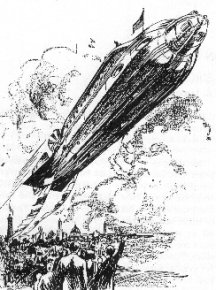 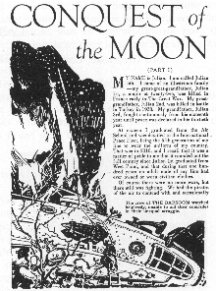 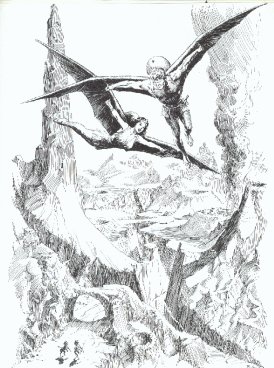
Moon Maid Illustrations
Its worth trying to untangle, but perhaps we'll save that untangling for another day....
|
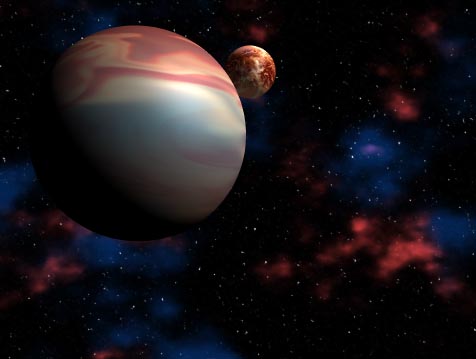 |
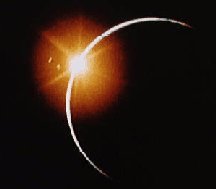 |
ERB
Artists Encyclopedia
|
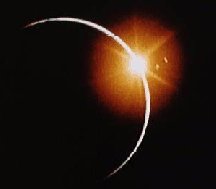 |
Navigation Chart For The Otis Adelbert Kline Features In ERBzine
|
Bios & Biblio |
Articles & Story |
Illustrated Biblio |
Bio-Film |
Weird Gallery/OAK Speaks |
Otis Adelbert Kline Features by Den Valdron
|
Mighty OAK of Barsoom Part 1 |
Mighty OAK of Barsoom Part 2 |
Otis Adelbert Kline's Venus |
The Other Moon Maid - Maza |
.
|
for Den Valdron's Fantasy Worlds of ERB |
![]()
![]()
![]()
![]()

![]()
BILL
HILLMAN
Visit
our thousands of other sites at:
BILL
and SUE-ON HILLMAN ECLECTIC STUDIO
ERB
Text, ERB Images and Tarzan® are ©Edgar Rice Burroughs, Inc.-
All Rights Reserved.
All
Original Work ©1996-2007/2017 by Bill Hillman and/or Contributing
Authors/Owners
No
part of this web site may be reproduced without permission from the respective
owners.